
An accomplished and highly recognized artist for more than twenty-five years, Lillian Pitt combines indigenous and contemporary motifs in her sculptures, masks, wearable art, and works on paper. Her work has been exhibited and reviewed nationally and internationally. She was the recipient of the Governor's Award of the Oregon Arts Commission in 1990, which declared that she had made, "significant contributions to the growth and development of the cultural life of Oregon.” In the first decade of the new millennium, Lillian extended her work into public spaces and parks as she and a team of Native American artists were commissioned by the city of Portland, the Oregon Convention Center, Portland State University, and a variety of other cultural institutions to create a series of public art pieces.
Lillian has been honored by a continuing artistic connection with Portland State University. Since 2000, the school has commissioned her to create several important public art projects, especially those with their Native American Student and Community Center. Her public art for PSU includes two rooftop sculptures and a fifty-foot totem pole that celebrates and allegorizes the journey of salmon in the Columbia Gorge from birth to their journey to the sea, to their home to spawn.
Beyond her contributions to the cultural vitality of the PSU campus, Pitt brings a wealth of knowledge to the educational life of the university and the city. In describing the source of her imagery, Lillian says “I use the ancient stories of my ancestors as a basis for the imagery I create. By doing this I maintain the memory of an ancient culture and keep the beliefs of my people alive. We have forgotten how to live in harmony with nature. Accessing this vast reservoir of traditional information and translating it into contemporary terms jogs our memories and provides points of reference to achieving balance within ourselves, our community and the world.”
Lillian describes herself as having been a stubborn child who developed an early fascination with the skills and stories of female elders. After a career as a hairdresser and beauty school instructor, Lillian went to community college to study ceramics. In her early thirties, she began to make clay masks inspired by female forms. “Having the tie with the earth, and then feeling and touching the earth, which is clay, was one of the first major passions that I've had about art work.”
The authority and wisdom of indigenous women powerfully animate the work of Lillian Pitt. Her series of masks represent the heroic elements of women’s lives, and the position of women as the bearers and preservers of culture. The Spider Woman mask honors the women who create and preserve the household, holding kinship ties together. But Pitt notes that many of her female masks invoke the spirit of the feminine in various spheres. “There is "Feather Woman" which she has an abstract eagle feather on her forehead which represents all women who are our teachers.” Pitt tells stories of women chiefs in her tribal traditions, and preserves these stories through other female images in the mask series, such as the Hawk Woman, and the Bird Woman, Coyote Woman, and Wolf Woman.
Lillian is part of the Warm Springs/Wasco and Yakama tribes of the Columbia River Gorge in the Pacific Northwest. Her work draws on the dramatic landscape of the Columbia River Gorge and the scientific and cultural knowledge of Native peoples. Her early artistic vision grew from the discovery in 1960 of “She Who Watches,” a petroglyph created by indigenous tribes that remains as a sentient presence—a stone perched above the mighty Columbia River to this day. As Lillian explains, “She Who Watches has become a signature piece for my career, is a source of personal inspiration as the original overlooked my great grandmother's village N’xluidix, and is a recurring image of significance for the middle Columbia River Chinookan peoples of which I am a descent. She is a charismatic figure, as well as a heroine of antiquity.”
Lillian offers the following story of the origins of her ancestors who settled thousands of years ago in the Columbia River Gorge:

“Coyote came along the river visiting the people to see how they were faring and ran into a village in which the people lived well, and were very happy. He asked to speak to their chief. She was a woman and lived in the rocks above the prosperous village of healthy people. He asked her if she was a good chief or one of those evildoers he had come across in the other villages. She replied, ‘I am a good woman, and a wise leader who taught her people how to build good houses, and gather enough food to live with abundance. He told her that the world was going to change soon, and women would no longer be chiefs. What would she wish for her people? She asked to stay with them, in perpetuity, to watch over them. I believe she reminds us of our early origins of peace and prosperity. He turned into the rock image we know today at the Horse Thief Lake Park in Washington State She is one of the only petroglyphs not destroyed or removed with the building of the dams."
A
source of inspiration to countless emerging artists and young
people with creative aspirations, Lillian Pitt never forgets
to honor the elders who went before her. “ In honoring our ancestors we honor all those who have lived on the earth
and shared similar materials, overcome obstacles in our environment and responded
to chaos by organizing principles of homage to legends, love for family, and
personal spiritual development.”